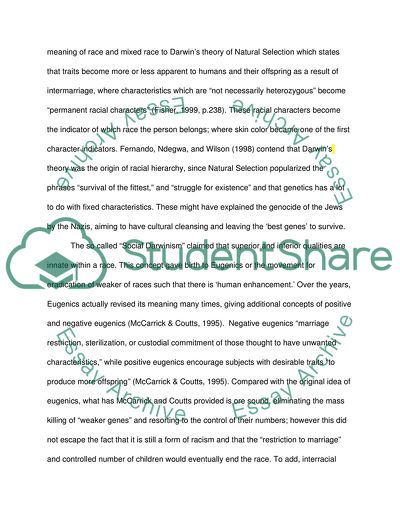Cite this document
(“Historically, people of mixed heritage have simultaneously and Essay - 1”, n.d.)
Historically, people of mixed heritage have simultaneously and Essay - 1. Retrieved from https://studentshare.org/miscellaneous/1575609-historically-people-of-mixed-heritage-have-simultaneously-and-contradictorily-been-identified-as-separate-from-both-black-and-white-people-and-consequently-pathologised-critically-evaluate-and-problematise-mixed-heritage-discourses
Historically, people of mixed heritage have simultaneously and Essay - 1. Retrieved from https://studentshare.org/miscellaneous/1575609-historically-people-of-mixed-heritage-have-simultaneously-and-contradictorily-been-identified-as-separate-from-both-black-and-white-people-and-consequently-pathologised-critically-evaluate-and-problematise-mixed-heritage-discourses
(Historically, People of Mixed Heritage Have Simultaneously and Essay - 1)
Historically, People of Mixed Heritage Have Simultaneously and Essay - 1. https://studentshare.org/miscellaneous/1575609-historically-people-of-mixed-heritage-have-simultaneously-and-contradictorily-been-identified-as-separate-from-both-black-and-white-people-and-consequently-pathologised-critically-evaluate-and-problematise-mixed-heritage-discourses.
Historically, People of Mixed Heritage Have Simultaneously and Essay - 1. https://studentshare.org/miscellaneous/1575609-historically-people-of-mixed-heritage-have-simultaneously-and-contradictorily-been-identified-as-separate-from-both-black-and-white-people-and-consequently-pathologised-critically-evaluate-and-problematise-mixed-heritage-discourses.
“Historically, People of Mixed Heritage Have Simultaneously and Essay - 1”, n.d. https://studentshare.org/miscellaneous/1575609-historically-people-of-mixed-heritage-have-simultaneously-and-contradictorily-been-identified-as-separate-from-both-black-and-white-people-and-consequently-pathologised-critically-evaluate-and-problematise-mixed-heritage-discourses.


